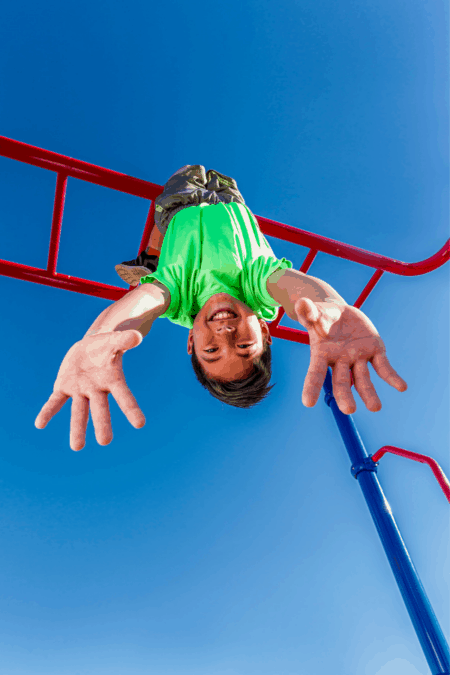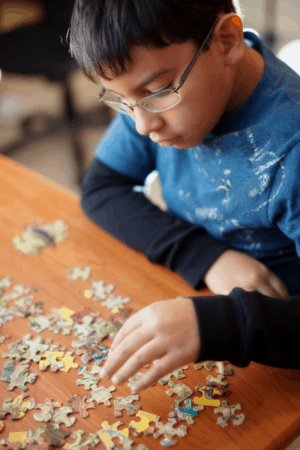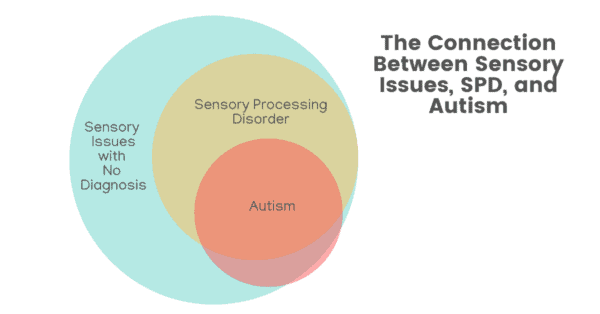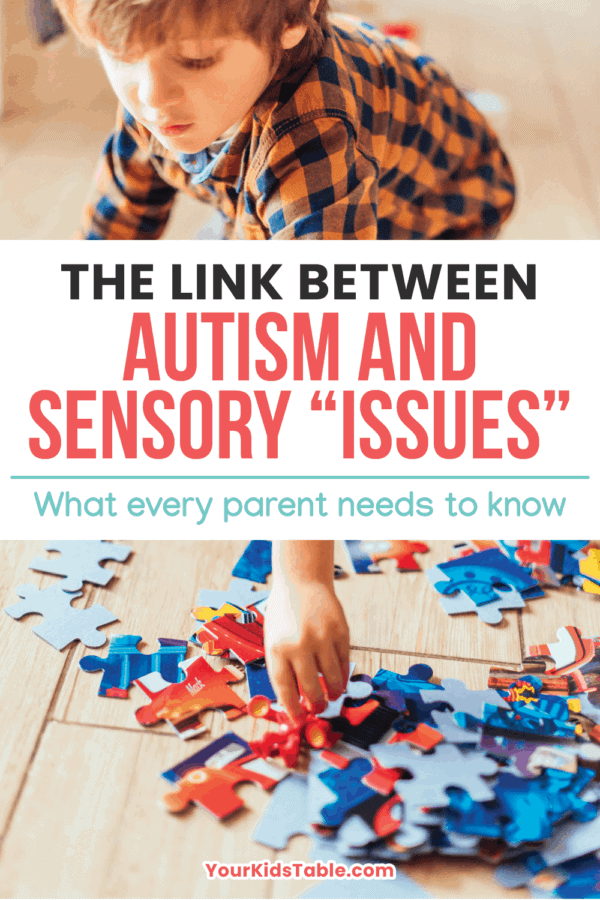As a pediatric OT, I’m always surprised at how many parents of kids with Autism (ASD) haven’t been told about the big link to sensory processing. Read on to learn about this important connection…
You’ve probably heard the staggering statistic that 1 in every 59 children have Autism. That’s a lot of kids. As an occupational therapist, I’ve stood next to dozens of families, including my own sister, as they tried to make sense of what this diagnosis meant for their child.
Once a child is diagnosed, it often feels like a whirlwind of confusion and overwhelm as they step into a new life of ABA or DIR floor time therapy for as much as 40 hours a week. Not to mention the speech therapy, occupational therapy, and possibly physical therapy. The options to consider for special diets, cutting edge supplements, and alternative therapies.
But, even with all of the information that parents are given, or in some cases left to figure out on their own, something very important slips through the cracks: sensory processing.
What is Sensory Processing?
Sensory processing is a part of every person’s brain function. It’s job is to take the sensations in from the environment (lights, sounds, tastes, smells, textures, movement, etc.) and make sense of it, or process it. Sensory processing is like a warehouse in our brain that sorts, organizes, and responds to any sensation you experience.
Your child is using their sensory processing when they ride a swing, eat a popsicle, or play in the sandbox.

What Does Sensory Have to Do With Autism?
Some experts estimate that at least 75% of all children with a diagnosis of Autism have a significant difficulty with sensory processing. That means most children with ASD have at least some sensory processing difficulties.
That percentage rate would go up if moderate and mild difficulties were considered too.
Which is why I’m still shocked at how many times I’m the first person to tell a parent of a child with Autism that sensory can have a lot to do with the behaviors and challenges, including Autism Meltdowns, they’re dealing with every day.
A few years back, I was talking to my neighbor whose son has Autism. Her schedule was packed with every kind of therapy almost all day long, including occupational therapy. He had already been in therapy for years, so I said, “Do you use a lot of sensory activities with him?” She looked a little uncomfortable and confused.
I assumed that this was part of his regular treatment, but my sweet neighbor barely had any idea what I was talking about.
I was thunderstruck, and kind of ticked off because I knew sensory was probably an incredibly valuable way to help her son make progress.

Why Sensory Activities Can Be Almost Like Magic…
Of course, as soon as I realized that my neighbor needed filled in on the sensory – autism connection, I slowly began to give her examples of how sensory activities can improve attention, interactions, and even eye contact.
The brain needs sensations to develop well. To learn, communicate, and socialize with peers.
When sensory processing isn’t working well, your child may experience the sensations, but they don’t get processed well. It’s like the warehouse of a brain loses the package or there’s a traffic jam. The child craves more or may seem totally uninterested and zoned out because their brain isn’t getting the right amount of sensory stimulation.
Or, the brain might over-process the sensations. It over reacts to sensations.
When this happens, kids are fearful, scared, and avoid sensations because they’re too intense.
Specific sensory activities can be used with kids that experience these difficulties in their sensory processing to help their brain learn to process sensations better. What’s really amazing is when you do a sensory activity with a child that was just what they needed, like magic, you see your child with Autism make better eye contact, communicate, and connect to others.
When I worked in early intervention, a speech therapist friend of mine would always try to schedule her speech appointments right after mine because I used a lot of sensory activities in my session. As a result, the child would often have increased speech and make greater strides in their speech session.
Why, because their sensory processing was working well as a result of the specific sensory activities and they could finally focus on speaking instead of trying to mange their sensory needs.
Some of my most treasured moments as a therapist have been when a child with Autism, who only had a few words and fleetingly made eye contact, would turn to me during a sensory activity, like a switch had been flipped, look directly into my eyes and say, “hi”.

Sensory “Issues” and Autism Is NOT a 2-Way Street
It is important to clarify though that Autism and sensory issues are not a 2-way street. If you have Autism, you almost certainly have at least some sensory processing difficulties, but lots of children have sensory processing difficulties and do NOT have Autism.
Some parents have heard of sensory, even though they may not fully understand it, and think that you can only have sensory issues with a diagnosis. Not true.
As I said earlier, we all have a sensory system in our brain, and just like any other aspect of development, your child may have some difficulties with sensory processing. Some children have significant sensory processing needs and receive a diagnoses of Sensory Processing Disorder (SPD).

This is a stand alone diagnosis, so a lot of kids have just a diagnosis of SPD.
But, it’s also possible for kids with Autism to also have a dual diagnosis of SPD and ASD. However, Sensory Processing Disorder is not recognized in the DSM, a manual doctors and other professionals use to diagnosis children.
Right now, mostly specialized occupational therapists will give a diagnosis of SPD, but it may not be recognized by your pediatrician or your insurance company, which can affect coverage of therapy services.
Sensory Symptoms + Signs in Children With Autism
It can be tricky to sort out what behaviors and actions are because of your child’s sensory processing. Here are some of the common sensory red flags you might see, particularly in children with ASD:
- Staring at spinning or flashing objects
- Running around non-stop
- Hand flapping
- Repeated actions
- Fixated on swinging
- Sensitivity to lights/sounds/smells/textures
- Climbing furniture dangerously
- Refuses to wear certain textures of clothing
- Will only eat specific colors or textures of food
- Touches, smells, or licks everything
- Chews on or mouths their shirt, pencils, and other random objects
- Bites people or objects for no apparent reason
- Likes to crawl into tight spaces or hide
- Spins in circles
- Brings objects very close to eyes to stare at
- Accidentally or intentionally bumps into other people or objects all the time
- Overwhelmed in public places
- Covers ears and has a meltdown
Often times, these behaviors start out as sensory in nature, but can become entangled over time with habits and coping strategies. Sensory is a piece of the solution in helping your child work through any of the behaviors above.
Because when these behaviors are done regularly, they interfere with learning, communication, socializing, and more.
A child’s brain sort of gets stuck trying to avoid or fill a sensation that it needs, and until it does, it will think of nothing more.
The first step though is figuring out what types of sensory needs your child has!
Do you see any of the signs in your child above? Have questions about other behaviors your child has that you don’t understand? Leave them in the comments below and we’ll give you our OT opinion on if it’s related to sensory.
21 Sensory Red Flags Free Printable
I’d love to put this helpful free printable of 21 different sensory red flags right in your hands so that you can figure out if there’s any other sensory links that you might have missed. Grab it below!
Click here to grab the free printable
More on Sensory Processing in Kids
Awesome Sensory Room Ideas That Calm Kids
How to Identify Sensory Issues in Toddlers
7 Awesome Sensory Activities Using a Yoga Ball
Alisha Grogan is a licensed occupational therapist and founder of Your Kid’s Table. She has over 15 years experience with expertise in sensory processing and feeding development in babies, toddlers, and children. Alisha also has 3 boys of her own at home. Learn more about her here.

My name is Katie. My son is 12 years old and was diagnosed 6 months ago with autism. I have been fighting for answers since he was 5 and finally this past school year he got the diagnosis. He has a sensitivity to loud noise. He will cover his ears when something or someone is too loud.He hand flaps when nervous, excited, upset, etc. He also claps his hands together when excited. He is easily overwhelmed in large crowds. I want to be able to help him as much as I possibly can but unfortunately in the area we live there is extremely long waiting lists for anything involving autism. I have him on a 1 year waiting list for ABA therapy. What kinds of sensory activities would you recommend for us to do at home with him? Thank you so much for your time and expertise. Hope to hear back from you soon!
Hey Katie,
Thanks for reaching out, we understand how hard it can be! For starting, I would try noise cancelling headphones to help with the noises and give him an outlet when he need it. But also understanding what type of sensory differences he has is important to choose the correct sensory activities! I’d start with our free sensory workshop to understand more! You can save your seat here!
Best,
Desiree
Hello,
My almost 3 year old was diagnosed with autism a few weeks ago. I am still unsure if it’s the correct diagnosis. He is speech delayed but he starting to say more words, and three word sentences like “I want juice.” He is having trouble with consonants though, so he’d say the vowels. The ST says that as he progresses she can assess if he has apraxia of speech or not. Getting him to use his lips is the current treatment. In terms of sensory needs, I truly believe if I can get to the root of his sensory issues, it will help him to be more engaging and connect socially with his parents and kids around him. He primarily likes to lay down on the floor to look at wheels roll by. Or he’d look at items in the corner of his eyes or peer at books up close up above his head. Sometimes he squints. We have a balcony overlooking a cliff, so when we are doing therapy he looks out the window. Other times he looks uninterested in something and will have wandering eyes. It looks like he’s listening but his eyes are looking at something else. He loves to swing at the playground and loves his sensory swing at home. He W sits and likes to slouch on things or people. He enjoys sleeping almost under his dad haha. I can’t seem to find a lot of information on hyposensitive children. I’m also confused about the right amounts of sensory stimulation because I see that sometimes my child can be an avoider and likes to leave the therapist and me to do something on his own. I know that was a lot of information. Thank you for any feedback you can provide! I’m going to look for your sensory workshop. Not sure if it’s still being offered.
Hi Minty,
We are so glad you reached out! Addressing sensory needs can definitely help to improve social engagement. You are right on track there! You want to look for activities that are alerting if your child is hyposensitive. Often proprioceptive activities like jumping on a trampoline might be a good place to start. They can be alerting to some kids and calming to others. Alerting tastes and smells (like lemon or orange) might also be helpful. We also have a list of 100 Sensory Activities that you might want to check out to give you some ideas.
Our free sensory workshop should be opening back up in the next couple of weeks. You can periodically check back on the “free workshops” tab of the main page for it. It should be there soon!
I hope that helps give you some ideas!
Best,
Andrea
Your Kids Table Team
My child is 2 years old and highly sensory seeking. She climbs furniture dangerously and chews on objects most often. She seems to be seeking a lot of swinging and vestibular input. Occasionally, she likes to run and likes her tight, enclosed spaces, like a car seat or a tent. She fills in her favorite songs and cartoons. She has words and some gestures, but doesn’t use them to express herself. Unfortunately, due to Covid, she has not been around other children in a year and so we don’t know what her interaction would be like. We have just started speech therapy and sensory integration occupational therapy which is not covered by our state services or insurance. We are told that if she is diagnosed as autistic, we will get more coverage. What qualifies or what makes a child with such sensory issues, autistic?
Hey Kanika,
While MANY children with Autism have sensory needs, it can go the other way as well with having only sensory needs and not being on the spectrum. I would reach out to your doctor for a list of red flags specifically for Autism. Typically they get a diagnosis from a psychological eveluation.
Hope that helps!
Best,
Desiree
My 3 years old boy has a speech delay also tends to climb on things. He likes to smell everything before he puts in he’s mouth. He’s constantly waving things close to he’s eyes and it’s always running around the house.
Hi Camila,
These sound like sensory seeking behavior, which this article may help clarify. But definitely reach out to your pediatrician for assistance if you have concerns and they can help with a referral.
Best,
Laura
Your Kid’s Table team member
What are some strategies to help with vestibular sensory processing? Also, my son will only eat crunchy textures, do you have any advice on maybe what to eat or how to introduce a new food?
Hey Karlie,
For Vestibular input you can check out our article HERE. As for the food I’d recommend checking out our free workshop. It’s a really good first step to working on picky eating! You can save your seat HERE
Best,
Desiree
What is, or is there even, a link between speech/language/communication delays and sensory processing?
My son is 3. He is not autistic but has sensory processing issues related to his proprioceptive and vestibular senses, and possibly one with hearing although he passed a hearing test. Maybe he can’t pull a voice out of the background noises?
He also is delayed in areas of speech, language, and communication. A few months ago he was performing at an 18 month old level.
Hey Cami,
Yes, there definitely can be a connection there. Depending on what his sensory needs are weather it’s getting him in a quite space without background distractions, or making sure he has time to move and jump on the trampoline will impact his ability to focus/talk/communicate. When their body isn’t getting what they need or is in overload it’s hard to focus on anything else. Hope that helps explain is some, but a lot of times SLP’s do work with OT’s to do the sensory part while they work on SLP or provide SLP after as the child is more accepting!
Best,
Desiree
My son is 9 years and have almost all of the above sensory processing
Hey Teresa,
Yes, sensory processing once you realize it can be so helpful. Keep a look out for our free workshop coming up soon! You can learn even more about sensory activities!
Best,
Desiree
My son is 9 and definitely has some behaviors:
Chews on shirt’
doesn’t like loud noises
definite repetitive behaviors – one dr. likened it to getting “stuck” on something, like a skipping record
Only wants to wear PJs at home. HATES underwear (although, really…who doesn’t?!)
Misinterprets perceived “slights” to his person
He used to hide under the table at school, but that was more K and 1st.
2nd grade was so much better.
He’s been homeschooled this year and has seemed to make great progress in not being quite as “stuck.” I’m wondering if a sense of anxiety doesn’t contribute to the behaviors.
We did get him a chew necklace, but are unsure of other activities that might help to settle him. He doesn’t have too many meltdowns, but I’d like to do whatever I can to increase his confidence.
Hey Tracie,
Yes, we hear you, it can be hard. Be on the look out for our free workshop coming up soon all about sensory activities. In regard to clothing you can check out this article. And if you are looking for information on anxiety you can check this out
Best,
Desiree
My son is 7. Has been receiving speech therapy since 3. His most recent evaluation that tested for Autism qualified him for OT. He has not been officially diagnosed, the evaluation was done by the school and results showed very similar to those of Autistic children in a school setting. We are currently homeschooling. The one on one time has worked really well for him.
My son doesn’t have any meltdowns.
He makes eye contact
He started speaking at 3 but now that he is 7 he is speaking so much.
He shows wide range of emotions
Is starting to read and write
Has been fixated on trains, ships and legos since very small
Engages in repetitive behavior from how he plays with toys, story he tells over and over, songs he likes, quotes characters, repeats movies and episode, bangs head on soft objects like pillows, couches or beds, jumps , climbs on couches.
Has a hard time concentrating for long periods of time. Has been described as slow in school setting but at home he can be very hyper at times and extremely calm at others.
He is a picky eater, but is getting better at trying new things.
Shows some discomfort in some sounds, lights or crowds, but manages most of the time.
Has a hard time playing with other children because his communication is limited. He can talk and he does but he has a hard time doing so and expressing himself.
I don’t know what his sensory needs are.
Hey Perla,
So happy he qualified for OT services! The OT should be able to provide you with sensory activities that he is looking for in certain situations as it will most likely not be the same across the board. When he is doing a specific activity such as “banging his head” he is most likely looking for input, so making sure to replace that with another activity that is safe for him. We do have a free workshop coming up with regards to sensory, so keep your eye out!
Best,
Desiree
Hello. Will the details on the workshop be sent out in email or where should we look? Thanks !
Yes, we will be sending it out via email! It will be opening up on the 24th this month 🙂
Best,
Desiree
hi, question from your last sentence, how exactly do you determine what types of sensory needs the child has?
my son:
chews on shirt
only eats a few foods..white or tan in color
sensitive to light and noise
And then, what can we do at home to work on this?
Hey Beth,
Yes, these can all be sensory signs! When chewing on shirt you can replace that with something that is more appropriate for them to be chewing on ie: chewy tube or chewlery. The feeding piece/picky eating often does have a sensory component as well. I’d check out this article. Also, keep your eye out for our free sensory workshop coming up all about sensory activities!
Best,
Desiree
My 2 year old excels in receptive but has been receiving speech since 18 months. He does like to spin. Chews on his “burpee” (the small burp rags we used to use and found he liked napping w them). He does like to run laps around our coffee table. Loves music. Will run into us/wrestle though I feel may be at appropriate play times.
He does his share of eye contact and ignoring esp if tv is on and you call his name, but you can talk about what’s on tv, like Blippi who he loves to copy.
My pediatrician wasn’t concerned w autism.
Just curious if these seem like just normal sensory issues!
Thank you
I you are in USA you can contact your county Early intervention center. You just send an email to them or phone call. It is self referral! They will do overall evaluation, it is free! My ped was always having little concerns unless it is something very evident. Our OT gave us a lot of advises to whom contact and send useful notes to our ped so we can get the referrals to other specialists. OT was our first person to help us with my baby, ped gave a referral bc my baby was not eating solid food at 1 year old of age.
My daughter has just turned two. She doesn’t speak at all. She doesn’t flap or spin or anything. But she does put things close to her face, does weird hand movements, is very fussy with food and does stare at lights and gets distracted by them. She cannot pay attention to one thing for more than about a minute at a time. She makes constant noises but no words. She is fine in public places and with other people and has joined nursery no problem. We have had a glue ear diagnosis and are waiting on more tests but I’m sure there is something more.
Hey Georgina,
That does sound like there could be some sensory things happening with her that she is looking for! Trying to pinpoint sensory needs can really help them be able to focus to say/understand language. Make sure to keep your eye out for our free workshop coming up soon, it’ll be helpful for understanding more sensory information!
Best,
Desiree
I’ve heard about glue ear diagnosis, such kids will still say something, it is just not understandable. Once she has good hearing she won’t start talking (i personally do not believe in such miracle). I just started speech therapy for my 18 months old and I can tell you it is worth to do! SLP will help her to increase attention span, improve play skills, it is not just about speech but also pre-skills needed for speech itself. In USA you have 2 options: get a referral from your ped through your insurance (wait list 6 months in my place) or contact early intervention (i get speech therapy from them while I am on wait list). Speech therapy will not solve all issues for your kid and you still need to research other help for her. This site has a lot of useful info! You can also read the book: The Out-of-Sync Child
Hey Lisa,
All of these do sound like he’s just looking for sensory input. I would try to replace anything that he can’t do with a sensory activity that is more appropriate. Something like crashing into pillows instead of people can be helpful! Also, keep your eye out on our free sensory workshop coming up in the next couple of weeks!
Best,
Desiree
Also a few more I forgot as I was just checking your list.
Another one is we will be talking to him but he doesn’t seem to “hear” or understand what we’re saying to him.
Another is he has EXTREME sensitivity to getting his hair cut. Especially when trying to cut around the ears. His meltdowns are never worse than when we try and cut his hair. He absolutely HATES it.
Hey Lydia,
So glad you are seeing the connection there! I would keep you eye out for our upcoming free sensory workshop! Sensory strategies can be really helpful!
Best,
Desiree
My 5yr old son, whom we suspect is Autistic has some of the “red flag markers”.
He chews on his shirt and other random objects like nerf gun darts.
He often runs around the kitchen in circles for several minutes.
He has some pretty terrible meltdowns.. especially if I’m in another room, he doesn’t know where I am, and he thinks I’ve “left” him.
He flaps his hands when he gets excited.
When his Older sister plays video games and it’s time to turn them off, even with a timed warning, he still gets VERY upset and melts down.
He also is very easily overwhelmed in public places. Especially when going out and playing with his friends. He will play for a little while but spend a majority of the time playing by himself.
He is also significantly behind in his speech and comprehension for his age.
My son, who will be four in April, is very talkative and a bit of a storyteller. However when presented with challenges such as identifying numbers, letters etc he gets very evasive. He also portrays the below characteristics from your list-
Staring at spinning or flashing objects briefly
Running around non-stop
Fixated on swinging
Sensitivity to lights/sounds/smells/textures
Climbing furniture dangerously
Refuses to wear certain textures of clothing and gets very upset
Will only eat specific colors or textures of food
Touches, smells, or licks random objects
Chews on or mouths their shirt, pencils, and other random objects
Likes to crawl into tight spaces or hide, especially if he is doing something wrong, scolded or told to stop
Spins in circles occasionally when playing
Brings objects very close to eyes to stare at, especially lights
Accidentally or intentionally bumps into other people or objects all the time, knocks things over on purpose sometimes and the explains or asks about it
My daughter is going to be 18 months
also does the following all the time when she is in her high chair or seated:
Hand flapping and/or rocking back and forth in an excited way
Thanks for sharing your story with us! Yes, I’d look into trying some sensory strategies to help them be able to stay focused and receive the input they are looking for!
You can check out some sensory strategies on our site as well as keep a look out for our upcoming free sensory workshop!
Best,
Desiree
My HF ASD daughter talks or hums nonstop. Is this a sensory issue? Is there a way for her to get that need met without all the jabbering? She said its not the sound but the act of talking/humming/singing she seeks. Thanks.
Yes, it very well could be. Since she was able to verbalize it is not the sound but the act of moving her mouth/doing it. You can try to replace it with something else more appropriate for her mouth to be doing/receiving input. Depending on her age you can try chewing gum, also sucking thick liquids through a straw can be helpful, crunchy snacks such as thick pretzel rods, these all provide input so trying them out throughout the day so that she is constantly getting the input may help decrease her humming/singing/etc. But it is finding what works for her!
Best,
Desiree